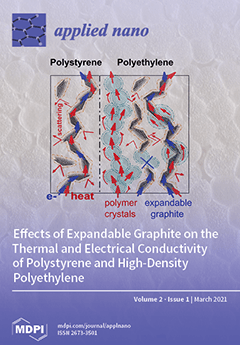In this work, we prepared and investigated two series of polymer composites, wherein the matrix was either an amorphous polystyrene (PS) or a semicrystalline high-density polyethylene (HDPE) filled with expandable graphite (EGr) at relatively high loadings within the range 5–55 wt %. For
[...] Read more.
In this work, we prepared and investigated two series of polymer composites, wherein the matrix was either an amorphous polystyrene (PS) or a semicrystalline high-density polyethylene (HDPE) filled with expandable graphite (EGr) at relatively high loadings within the range 5–55 wt %. For the investigation we employed a thermogravimetric analysis and differential scanning calorimetry to assess the thermal transitions and evaluate the various polymer fractions (crystalline (CF), mobile (MAF) and rigid amorphous (RAF)) in addition to broadband dielectric spectroscopy and a laser flash analysis to evaluate the EGr effects on electrical conductivity,
σ, and thermal conductivity,
λ, respectively. In PS, EGr was found to impose an increase of the glass transition temperature and a systematic decrease of the corresponding heat capacity change. The latter was rationalized in terms of the formation of an interfacial RAF. No glass transition was recorded for HDPE whereas the fillers increased the CF moderately. As expected,
σ increased with the filler loading for both matrices, up to 10
−3–10
−2 S/cm, resulting in a conductive percolation threshold for electrons at > 8 wt % EGr. Simultaneously, the
λ of PS and HDPE were strongly increased, from 0.13 and 0.38 W·K
–1·m
–1 up to 0.55 and ~2 W·K
–1·m
–1, respectively.
λ demonstrated an almost linear EGr loading dependence whereas the semicrystalline composites exhibited a systematically higher
λ.
Full article



